LAW504: Business Law Assignment on Contracts and Partnerships
VerifiedAdded on 2022/12/28
|11
|2336
|1
Report
AI Summary
This report provides a detailed analysis of a Business Law assignment, addressing two key legal issues. The first question examines a scenario involving a restraint of trade clause within an employment contract. It explores the legal principles governing such clauses, including the Restraint of Trade Act 1976 (NSW) and the Competition and Consumer Act 2010, and applies them to determine whether an employee breached the clause by starting a competing business. The analysis considers the reasonableness and necessity of the restraint, the potential legal actions by the former employer and a bank, and the employee's possible defenses. The second question focuses on partnership law, specifically the liabilities of partners in a limited partnership, and the implications of their actions. It examines the legal framework under the Partnership Act 1892 (NSW), including joint and several liabilities, wrongful acts, and breaches of partnership agreements. The application section evaluates the partners' liabilities arising from various transactions and decisions, including a breach of agreement and misuse of funds, and advises on potential legal actions among the partners.
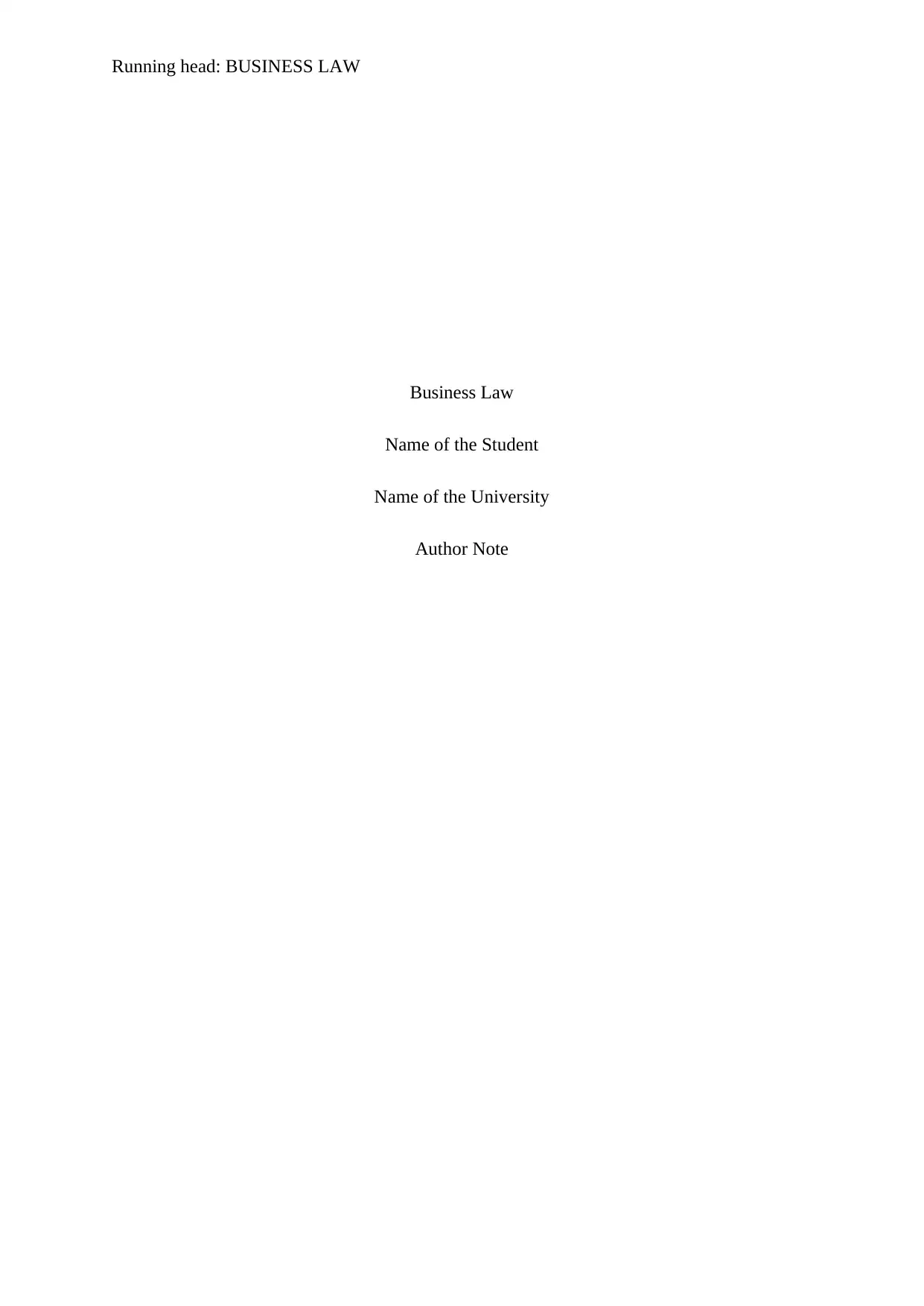
Running head: BUSINESS LAW
Business Law
Name of the Student
Name of the University
Author Note
Business Law
Name of the Student
Name of the University
Author Note
Paraphrase This Document
Need a fresh take? Get an instant paraphrase of this document with our AI Paraphraser

1BUSINESS LAW
Table of Contents
Question 1..................................................................................................................................2
Question 2..................................................................................................................................6
References..................................................................................................................................7
Table of Contents
Question 1..................................................................................................................................2
Question 2..................................................................................................................................6
References..................................................................................................................................7
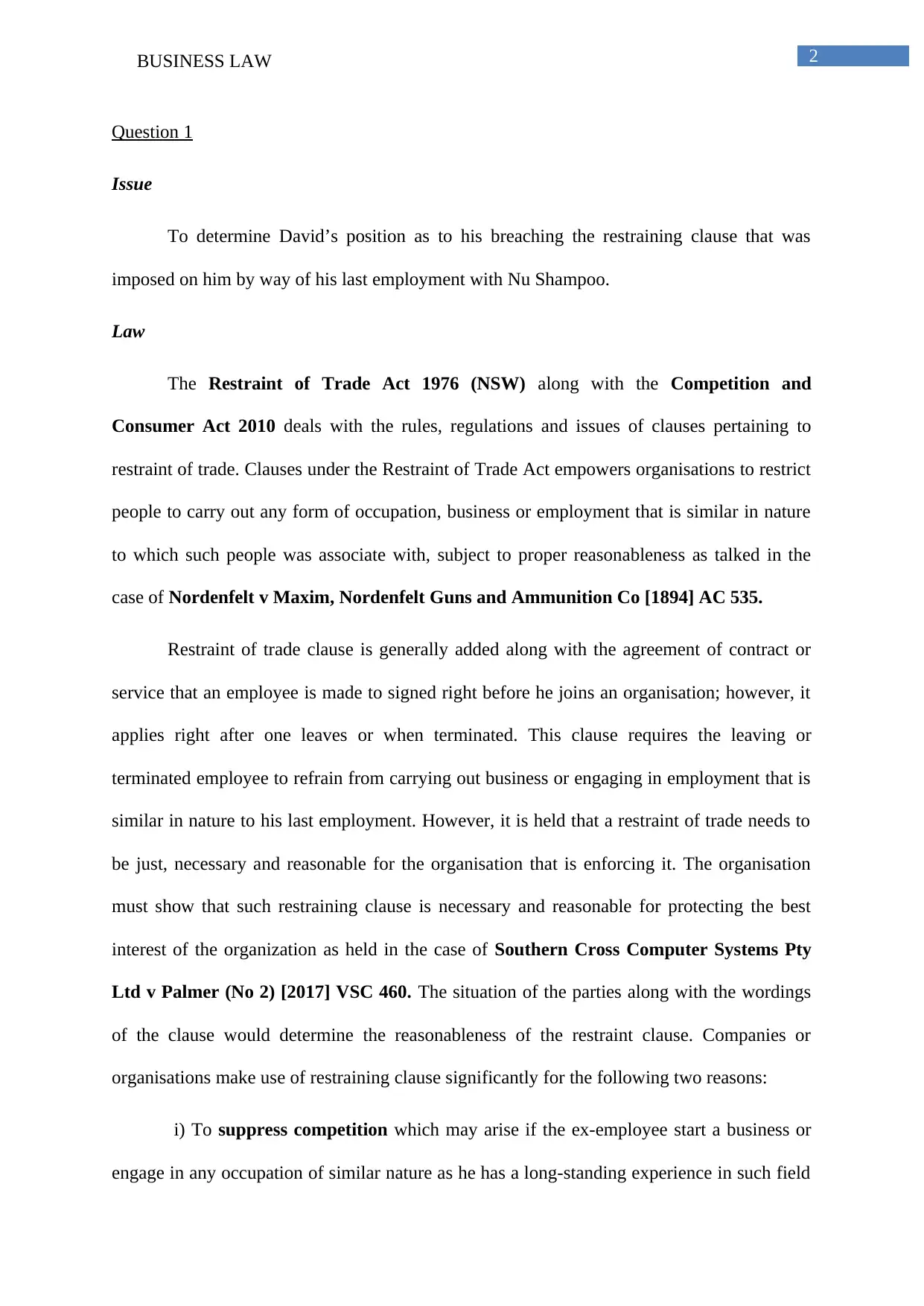
2BUSINESS LAW
Question 1
Issue
To determine David’s position as to his breaching the restraining clause that was
imposed on him by way of his last employment with Nu Shampoo.
Law
The Restraint of Trade Act 1976 (NSW) along with the Competition and
Consumer Act 2010 deals with the rules, regulations and issues of clauses pertaining to
restraint of trade. Clauses under the Restraint of Trade Act empowers organisations to restrict
people to carry out any form of occupation, business or employment that is similar in nature
to which such people was associate with, subject to proper reasonableness as talked in the
case of Nordenfelt v Maxim, Nordenfelt Guns and Ammunition Co [1894] AC 535.
Restraint of trade clause is generally added along with the agreement of contract or
service that an employee is made to signed right before he joins an organisation; however, it
applies right after one leaves or when terminated. This clause requires the leaving or
terminated employee to refrain from carrying out business or engaging in employment that is
similar in nature to his last employment. However, it is held that a restraint of trade needs to
be just, necessary and reasonable for the organisation that is enforcing it. The organisation
must show that such restraining clause is necessary and reasonable for protecting the best
interest of the organization as held in the case of Southern Cross Computer Systems Pty
Ltd v Palmer (No 2) [2017] VSC 460. The situation of the parties along with the wordings
of the clause would determine the reasonableness of the restraint clause. Companies or
organisations make use of restraining clause significantly for the following two reasons:
i) To suppress competition which may arise if the ex-employee start a business or
engage in any occupation of similar nature as he has a long-standing experience in such field
Question 1
Issue
To determine David’s position as to his breaching the restraining clause that was
imposed on him by way of his last employment with Nu Shampoo.
Law
The Restraint of Trade Act 1976 (NSW) along with the Competition and
Consumer Act 2010 deals with the rules, regulations and issues of clauses pertaining to
restraint of trade. Clauses under the Restraint of Trade Act empowers organisations to restrict
people to carry out any form of occupation, business or employment that is similar in nature
to which such people was associate with, subject to proper reasonableness as talked in the
case of Nordenfelt v Maxim, Nordenfelt Guns and Ammunition Co [1894] AC 535.
Restraint of trade clause is generally added along with the agreement of contract or
service that an employee is made to signed right before he joins an organisation; however, it
applies right after one leaves or when terminated. This clause requires the leaving or
terminated employee to refrain from carrying out business or engaging in employment that is
similar in nature to his last employment. However, it is held that a restraint of trade needs to
be just, necessary and reasonable for the organisation that is enforcing it. The organisation
must show that such restraining clause is necessary and reasonable for protecting the best
interest of the organization as held in the case of Southern Cross Computer Systems Pty
Ltd v Palmer (No 2) [2017] VSC 460. The situation of the parties along with the wordings
of the clause would determine the reasonableness of the restraint clause. Companies or
organisations make use of restraining clause significantly for the following two reasons:
i) To suppress competition which may arise if the ex-employee start a business or
engage in any occupation of similar nature as he has a long-standing experience in such field
⊘ This is a preview!⊘
Do you want full access?
Subscribe today to unlock all pages.

Trusted by 1+ million students worldwide

3BUSINESS LAW
and he would most definitely make use of his rapport with the client of the restraining
organisation where he last worked.
ii) To prevent solicitation, which is the most common phenomenon noticed after an
employee leave an organization and starts his own venture on the same things that he was
involved with in his last employment.
A company must establish the fact that the restraint of trade clause put by an
organisation is reasonable and necessary for achieving the best interest of the company before
it tries to enforce the restraint. The court would however refuse to enforce the restraint clause
if it finds that was no necessity or reasonableness to impose such restraint on the employee ad
that it has a detrimental effect on a public policy. On finding sufficient protective reasons for
the organisation, the court shall most definitely enforce the restraint of trade clause.
To enforce a restraint clause, the court evaluates the following points to check the
merit of necessity and reasonableness of the restraint clause:
i) The nature of negotiation between the parties pertaining to the restraint clause,
ii) Position of the parties to bargain,
ii) restrained employee’s characteristics
iv) Whether or not the restraint employee was given some kind of compensation or damages
v) Time duration of such restraint, and
vi) Geographical location within which trade has been restrained.
All of these factors must push the decision of the organisation to be fair, reasonable and
necessary in order to be held as sufficient for establishing the enforceability of the restraint of
trade clause.
and he would most definitely make use of his rapport with the client of the restraining
organisation where he last worked.
ii) To prevent solicitation, which is the most common phenomenon noticed after an
employee leave an organization and starts his own venture on the same things that he was
involved with in his last employment.
A company must establish the fact that the restraint of trade clause put by an
organisation is reasonable and necessary for achieving the best interest of the company before
it tries to enforce the restraint. The court would however refuse to enforce the restraint clause
if it finds that was no necessity or reasonableness to impose such restraint on the employee ad
that it has a detrimental effect on a public policy. On finding sufficient protective reasons for
the organisation, the court shall most definitely enforce the restraint of trade clause.
To enforce a restraint clause, the court evaluates the following points to check the
merit of necessity and reasonableness of the restraint clause:
i) The nature of negotiation between the parties pertaining to the restraint clause,
ii) Position of the parties to bargain,
ii) restrained employee’s characteristics
iv) Whether or not the restraint employee was given some kind of compensation or damages
v) Time duration of such restraint, and
vi) Geographical location within which trade has been restrained.
All of these factors must push the decision of the organisation to be fair, reasonable and
necessary in order to be held as sufficient for establishing the enforceability of the restraint of
trade clause.
Paraphrase This Document
Need a fresh take? Get an instant paraphrase of this document with our AI Paraphraser

4BUSINESS LAW
Application
In this scenario, Nu Shampoo had signed a contract for employment with David
pertaining to his employment with the company that incorporated a restraint of trade clause.
Such restraint of trade clause directed David not to work for any hair-care product or start a
venture of his own in and around Sydney for a restraining tenure of 5 years. However after
resigning from Nu shampoo, David started a company around South Australia called Hair-
Glo Pty Ltd which was similar to his previous company Nu Shampoo Pty Ltd. This implies
that David had intention to compete with Nu Shampoo and make it challenging for it to carry
out business in the same area and also with the same clients for David was quite experienced
in this field along with having good contacts with his clients from Nu Shampoo. Therefore, it
can be implicated that David had breached his restraint of trade clause that he had signed with
his last employer. Therefore, this could lead to a legal action against David by Nu Shampoo
for breaching their restraint clause and thereby affecting their business.
There could be another legal action that can be brought by Standard Bank against
Hair-Glo as the company had taken a loan of $1 million in the form of start-up capital while it
had started its business. Although the bank did not require any security or mortgage for
passing the loan, yet it still can recover the default instalment of $10000 that Hair-Glo failed
to pay back as a result for its poor performance in 2019. Therefore, Standard Bank can sue
Hair-Glo for recovering its instalment that the company failed to pay.
Nu Shampoo could sue David on the grounds of breaching its restraint clause which
was part of the agreement for service that was signed by David when he had been hired to
work with Nu shampoo. Nu shampoo would be, however, made to establish that the restraint
imposed by them is necessary and reasonable for protecting their own business from unfair
competition as David was an experience person in hair-care industry and had good contact
with several of Nu shampoo’s clients which he would certainly try to take away to his own
Application
In this scenario, Nu Shampoo had signed a contract for employment with David
pertaining to his employment with the company that incorporated a restraint of trade clause.
Such restraint of trade clause directed David not to work for any hair-care product or start a
venture of his own in and around Sydney for a restraining tenure of 5 years. However after
resigning from Nu shampoo, David started a company around South Australia called Hair-
Glo Pty Ltd which was similar to his previous company Nu Shampoo Pty Ltd. This implies
that David had intention to compete with Nu Shampoo and make it challenging for it to carry
out business in the same area and also with the same clients for David was quite experienced
in this field along with having good contacts with his clients from Nu Shampoo. Therefore, it
can be implicated that David had breached his restraint of trade clause that he had signed with
his last employer. Therefore, this could lead to a legal action against David by Nu Shampoo
for breaching their restraint clause and thereby affecting their business.
There could be another legal action that can be brought by Standard Bank against
Hair-Glo as the company had taken a loan of $1 million in the form of start-up capital while it
had started its business. Although the bank did not require any security or mortgage for
passing the loan, yet it still can recover the default instalment of $10000 that Hair-Glo failed
to pay back as a result for its poor performance in 2019. Therefore, Standard Bank can sue
Hair-Glo for recovering its instalment that the company failed to pay.
Nu Shampoo could sue David on the grounds of breaching its restraint clause which
was part of the agreement for service that was signed by David when he had been hired to
work with Nu shampoo. Nu shampoo would be, however, made to establish that the restraint
imposed by them is necessary and reasonable for protecting their own business from unfair
competition as David was an experience person in hair-care industry and had good contact
with several of Nu shampoo’s clients which he would certainly try to take away to his own
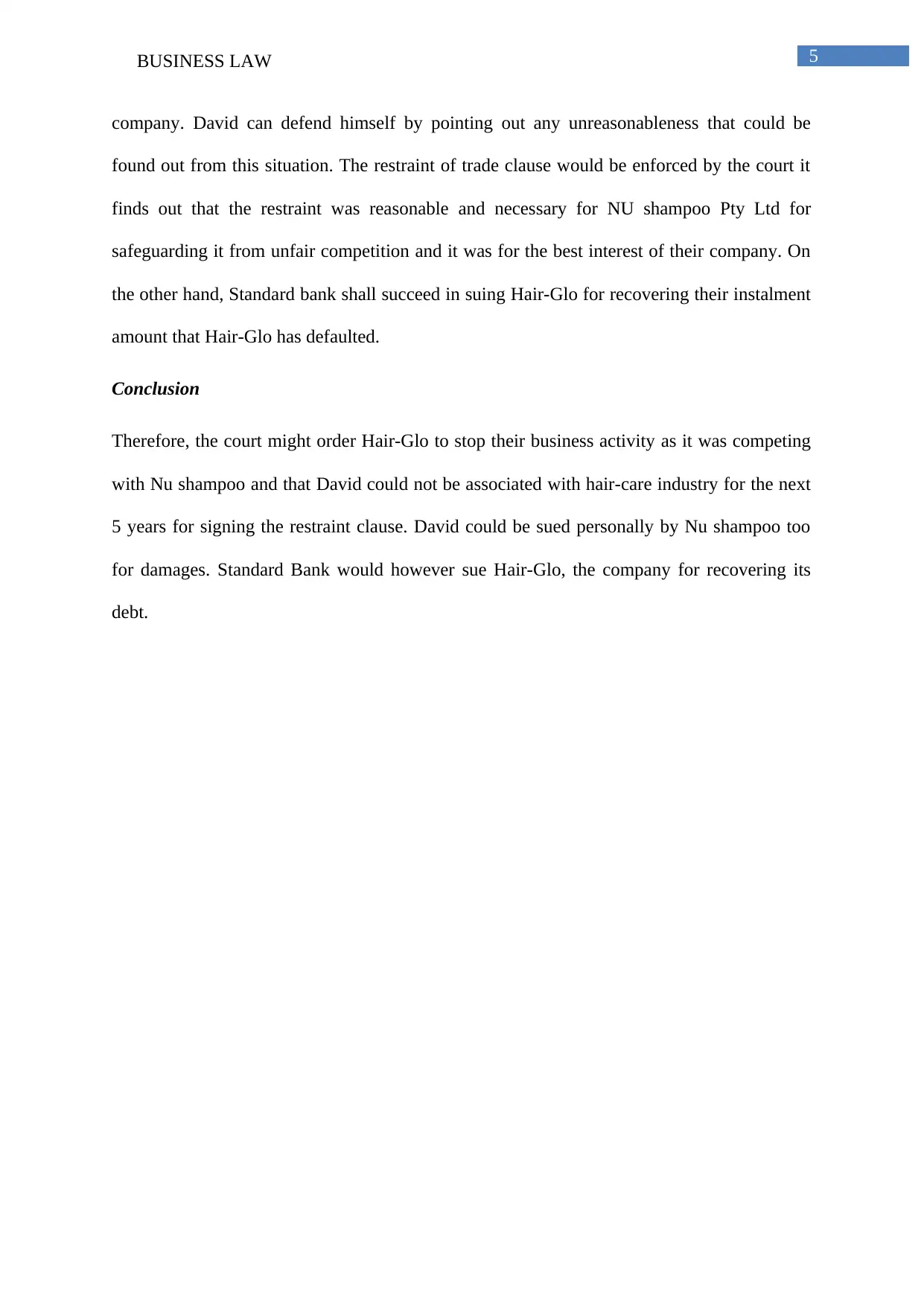
5BUSINESS LAW
company. David can defend himself by pointing out any unreasonableness that could be
found out from this situation. The restraint of trade clause would be enforced by the court it
finds out that the restraint was reasonable and necessary for NU shampoo Pty Ltd for
safeguarding it from unfair competition and it was for the best interest of their company. On
the other hand, Standard bank shall succeed in suing Hair-Glo for recovering their instalment
amount that Hair-Glo has defaulted.
Conclusion
Therefore, the court might order Hair-Glo to stop their business activity as it was competing
with Nu shampoo and that David could not be associated with hair-care industry for the next
5 years for signing the restraint clause. David could be sued personally by Nu shampoo too
for damages. Standard Bank would however sue Hair-Glo, the company for recovering its
debt.
company. David can defend himself by pointing out any unreasonableness that could be
found out from this situation. The restraint of trade clause would be enforced by the court it
finds out that the restraint was reasonable and necessary for NU shampoo Pty Ltd for
safeguarding it from unfair competition and it was for the best interest of their company. On
the other hand, Standard bank shall succeed in suing Hair-Glo for recovering their instalment
amount that Hair-Glo has defaulted.
Conclusion
Therefore, the court might order Hair-Glo to stop their business activity as it was competing
with Nu shampoo and that David could not be associated with hair-care industry for the next
5 years for signing the restraint clause. David could be sued personally by Nu shampoo too
for damages. Standard Bank would however sue Hair-Glo, the company for recovering its
debt.
⊘ This is a preview!⊘
Do you want full access?
Subscribe today to unlock all pages.

Trusted by 1+ million students worldwide
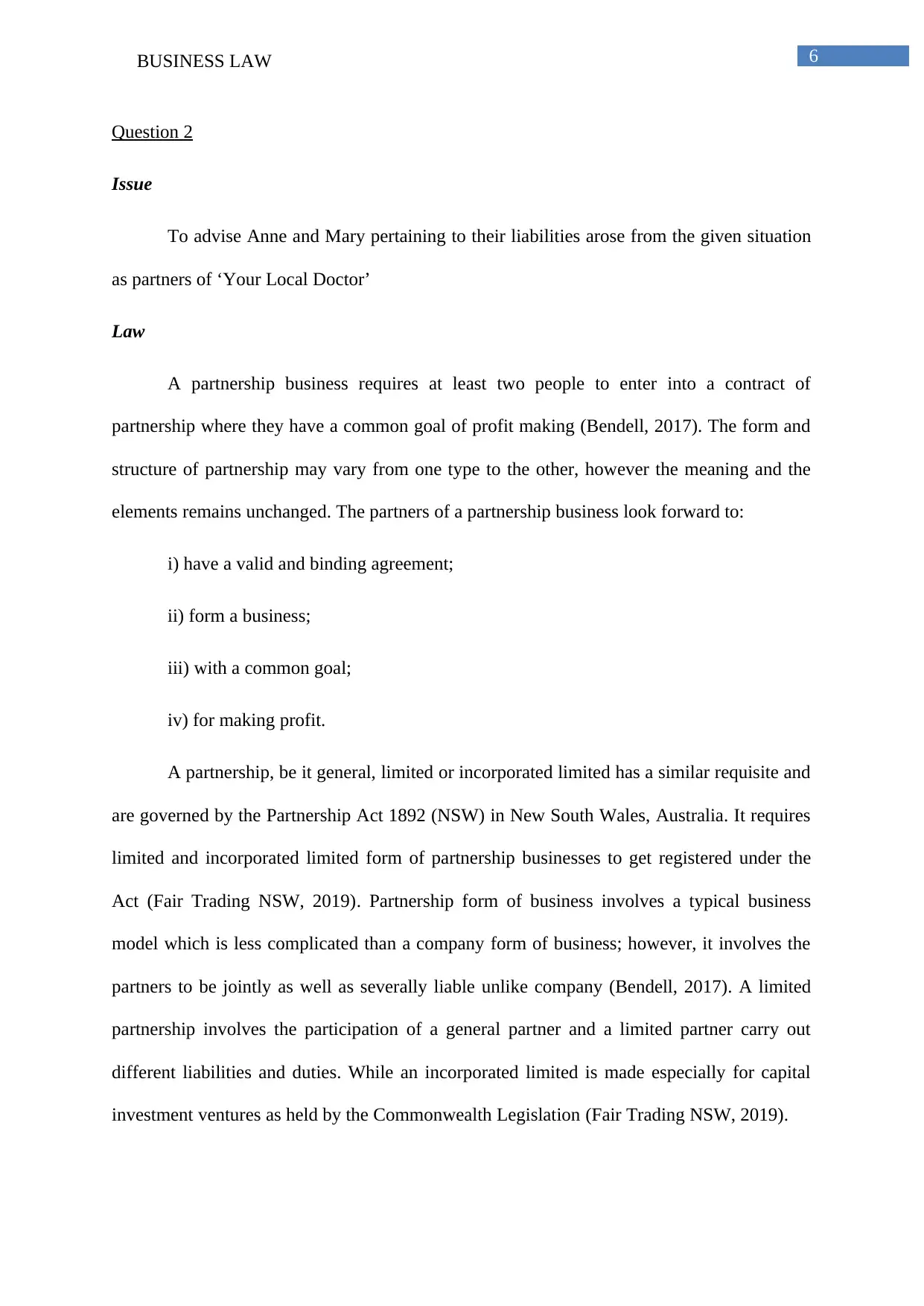
6BUSINESS LAW
Question 2
Issue
To advise Anne and Mary pertaining to their liabilities arose from the given situation
as partners of ‘Your Local Doctor’
Law
A partnership business requires at least two people to enter into a contract of
partnership where they have a common goal of profit making (Bendell, 2017). The form and
structure of partnership may vary from one type to the other, however the meaning and the
elements remains unchanged. The partners of a partnership business look forward to:
i) have a valid and binding agreement;
ii) form a business;
iii) with a common goal;
iv) for making profit.
A partnership, be it general, limited or incorporated limited has a similar requisite and
are governed by the Partnership Act 1892 (NSW) in New South Wales, Australia. It requires
limited and incorporated limited form of partnership businesses to get registered under the
Act (Fair Trading NSW, 2019). Partnership form of business involves a typical business
model which is less complicated than a company form of business; however, it involves the
partners to be jointly as well as severally liable unlike company (Bendell, 2017). A limited
partnership involves the participation of a general partner and a limited partner carry out
different liabilities and duties. While an incorporated limited is made especially for capital
investment ventures as held by the Commonwealth Legislation (Fair Trading NSW, 2019).
Question 2
Issue
To advise Anne and Mary pertaining to their liabilities arose from the given situation
as partners of ‘Your Local Doctor’
Law
A partnership business requires at least two people to enter into a contract of
partnership where they have a common goal of profit making (Bendell, 2017). The form and
structure of partnership may vary from one type to the other, however the meaning and the
elements remains unchanged. The partners of a partnership business look forward to:
i) have a valid and binding agreement;
ii) form a business;
iii) with a common goal;
iv) for making profit.
A partnership, be it general, limited or incorporated limited has a similar requisite and
are governed by the Partnership Act 1892 (NSW) in New South Wales, Australia. It requires
limited and incorporated limited form of partnership businesses to get registered under the
Act (Fair Trading NSW, 2019). Partnership form of business involves a typical business
model which is less complicated than a company form of business; however, it involves the
partners to be jointly as well as severally liable unlike company (Bendell, 2017). A limited
partnership involves the participation of a general partner and a limited partner carry out
different liabilities and duties. While an incorporated limited is made especially for capital
investment ventures as held by the Commonwealth Legislation (Fair Trading NSW, 2019).
Paraphrase This Document
Need a fresh take? Get an instant paraphrase of this document with our AI Paraphraser
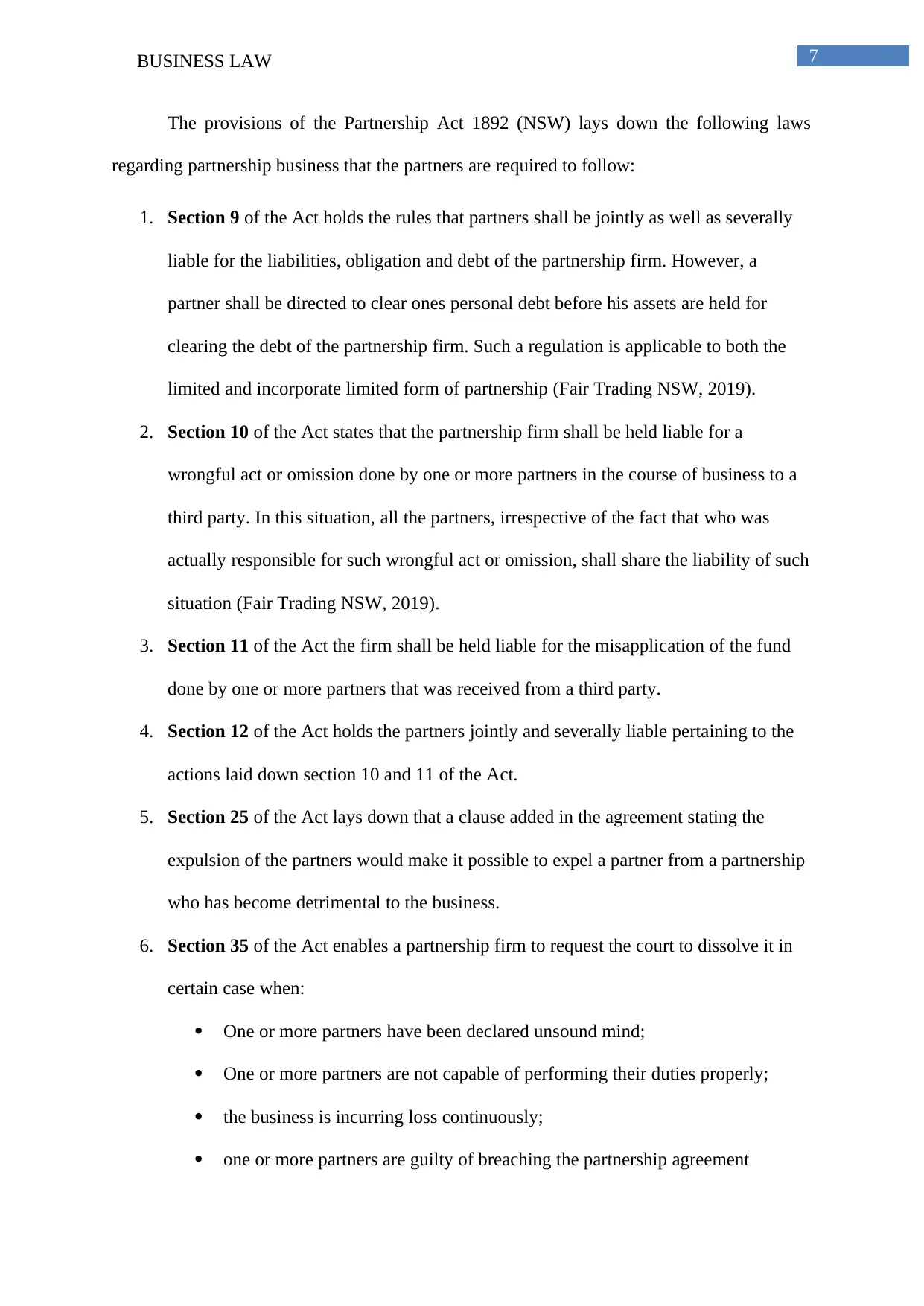
7BUSINESS LAW
The provisions of the Partnership Act 1892 (NSW) lays down the following laws
regarding partnership business that the partners are required to follow:
1. Section 9 of the Act holds the rules that partners shall be jointly as well as severally
liable for the liabilities, obligation and debt of the partnership firm. However, a
partner shall be directed to clear ones personal debt before his assets are held for
clearing the debt of the partnership firm. Such a regulation is applicable to both the
limited and incorporate limited form of partnership (Fair Trading NSW, 2019).
2. Section 10 of the Act states that the partnership firm shall be held liable for a
wrongful act or omission done by one or more partners in the course of business to a
third party. In this situation, all the partners, irrespective of the fact that who was
actually responsible for such wrongful act or omission, shall share the liability of such
situation (Fair Trading NSW, 2019).
3. Section 11 of the Act the firm shall be held liable for the misapplication of the fund
done by one or more partners that was received from a third party.
4. Section 12 of the Act holds the partners jointly and severally liable pertaining to the
actions laid down section 10 and 11 of the Act.
5. Section 25 of the Act lays down that a clause added in the agreement stating the
expulsion of the partners would make it possible to expel a partner from a partnership
who has become detrimental to the business.
6. Section 35 of the Act enables a partnership firm to request the court to dissolve it in
certain case when:
One or more partners have been declared unsound mind;
One or more partners are not capable of performing their duties properly;
the business is incurring loss continuously;
one or more partners are guilty of breaching the partnership agreement
The provisions of the Partnership Act 1892 (NSW) lays down the following laws
regarding partnership business that the partners are required to follow:
1. Section 9 of the Act holds the rules that partners shall be jointly as well as severally
liable for the liabilities, obligation and debt of the partnership firm. However, a
partner shall be directed to clear ones personal debt before his assets are held for
clearing the debt of the partnership firm. Such a regulation is applicable to both the
limited and incorporate limited form of partnership (Fair Trading NSW, 2019).
2. Section 10 of the Act states that the partnership firm shall be held liable for a
wrongful act or omission done by one or more partners in the course of business to a
third party. In this situation, all the partners, irrespective of the fact that who was
actually responsible for such wrongful act or omission, shall share the liability of such
situation (Fair Trading NSW, 2019).
3. Section 11 of the Act the firm shall be held liable for the misapplication of the fund
done by one or more partners that was received from a third party.
4. Section 12 of the Act holds the partners jointly and severally liable pertaining to the
actions laid down section 10 and 11 of the Act.
5. Section 25 of the Act lays down that a clause added in the agreement stating the
expulsion of the partners would make it possible to expel a partner from a partnership
who has become detrimental to the business.
6. Section 35 of the Act enables a partnership firm to request the court to dissolve it in
certain case when:
One or more partners have been declared unsound mind;
One or more partners are not capable of performing their duties properly;
the business is incurring loss continuously;
one or more partners are guilty of breaching the partnership agreement
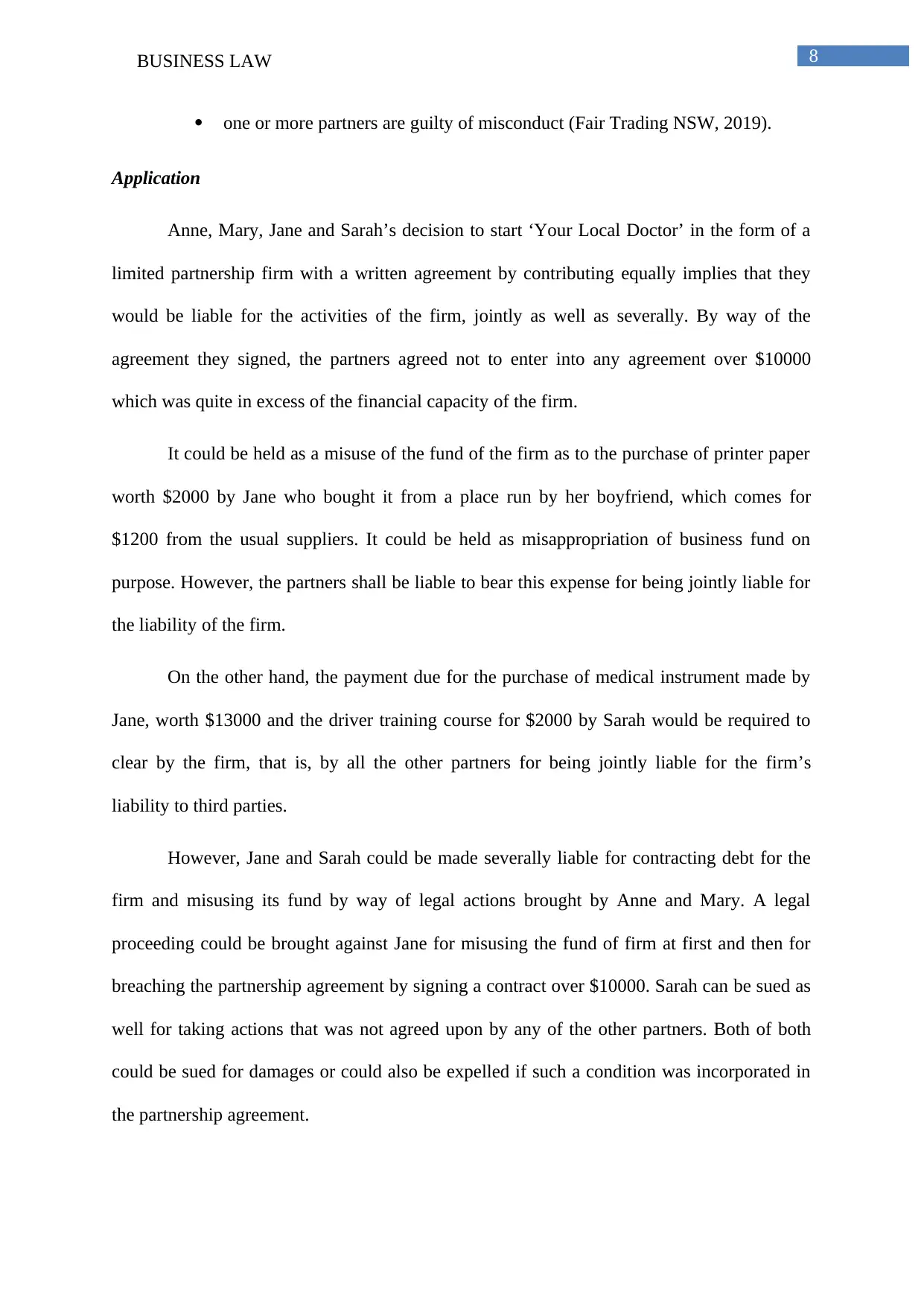
8BUSINESS LAW
one or more partners are guilty of misconduct (Fair Trading NSW, 2019).
Application
Anne, Mary, Jane and Sarah’s decision to start ‘Your Local Doctor’ in the form of a
limited partnership firm with a written agreement by contributing equally implies that they
would be liable for the activities of the firm, jointly as well as severally. By way of the
agreement they signed, the partners agreed not to enter into any agreement over $10000
which was quite in excess of the financial capacity of the firm.
It could be held as a misuse of the fund of the firm as to the purchase of printer paper
worth $2000 by Jane who bought it from a place run by her boyfriend, which comes for
$1200 from the usual suppliers. It could be held as misappropriation of business fund on
purpose. However, the partners shall be liable to bear this expense for being jointly liable for
the liability of the firm.
On the other hand, the payment due for the purchase of medical instrument made by
Jane, worth $13000 and the driver training course for $2000 by Sarah would be required to
clear by the firm, that is, by all the other partners for being jointly liable for the firm’s
liability to third parties.
However, Jane and Sarah could be made severally liable for contracting debt for the
firm and misusing its fund by way of legal actions brought by Anne and Mary. A legal
proceeding could be brought against Jane for misusing the fund of firm at first and then for
breaching the partnership agreement by signing a contract over $10000. Sarah can be sued as
well for taking actions that was not agreed upon by any of the other partners. Both of both
could be sued for damages or could also be expelled if such a condition was incorporated in
the partnership agreement.
one or more partners are guilty of misconduct (Fair Trading NSW, 2019).
Application
Anne, Mary, Jane and Sarah’s decision to start ‘Your Local Doctor’ in the form of a
limited partnership firm with a written agreement by contributing equally implies that they
would be liable for the activities of the firm, jointly as well as severally. By way of the
agreement they signed, the partners agreed not to enter into any agreement over $10000
which was quite in excess of the financial capacity of the firm.
It could be held as a misuse of the fund of the firm as to the purchase of printer paper
worth $2000 by Jane who bought it from a place run by her boyfriend, which comes for
$1200 from the usual suppliers. It could be held as misappropriation of business fund on
purpose. However, the partners shall be liable to bear this expense for being jointly liable for
the liability of the firm.
On the other hand, the payment due for the purchase of medical instrument made by
Jane, worth $13000 and the driver training course for $2000 by Sarah would be required to
clear by the firm, that is, by all the other partners for being jointly liable for the firm’s
liability to third parties.
However, Jane and Sarah could be made severally liable for contracting debt for the
firm and misusing its fund by way of legal actions brought by Anne and Mary. A legal
proceeding could be brought against Jane for misusing the fund of firm at first and then for
breaching the partnership agreement by signing a contract over $10000. Sarah can be sued as
well for taking actions that was not agreed upon by any of the other partners. Both of both
could be sued for damages or could also be expelled if such a condition was incorporated in
the partnership agreement.
⊘ This is a preview!⊘
Do you want full access?
Subscribe today to unlock all pages.

Trusted by 1+ million students worldwide
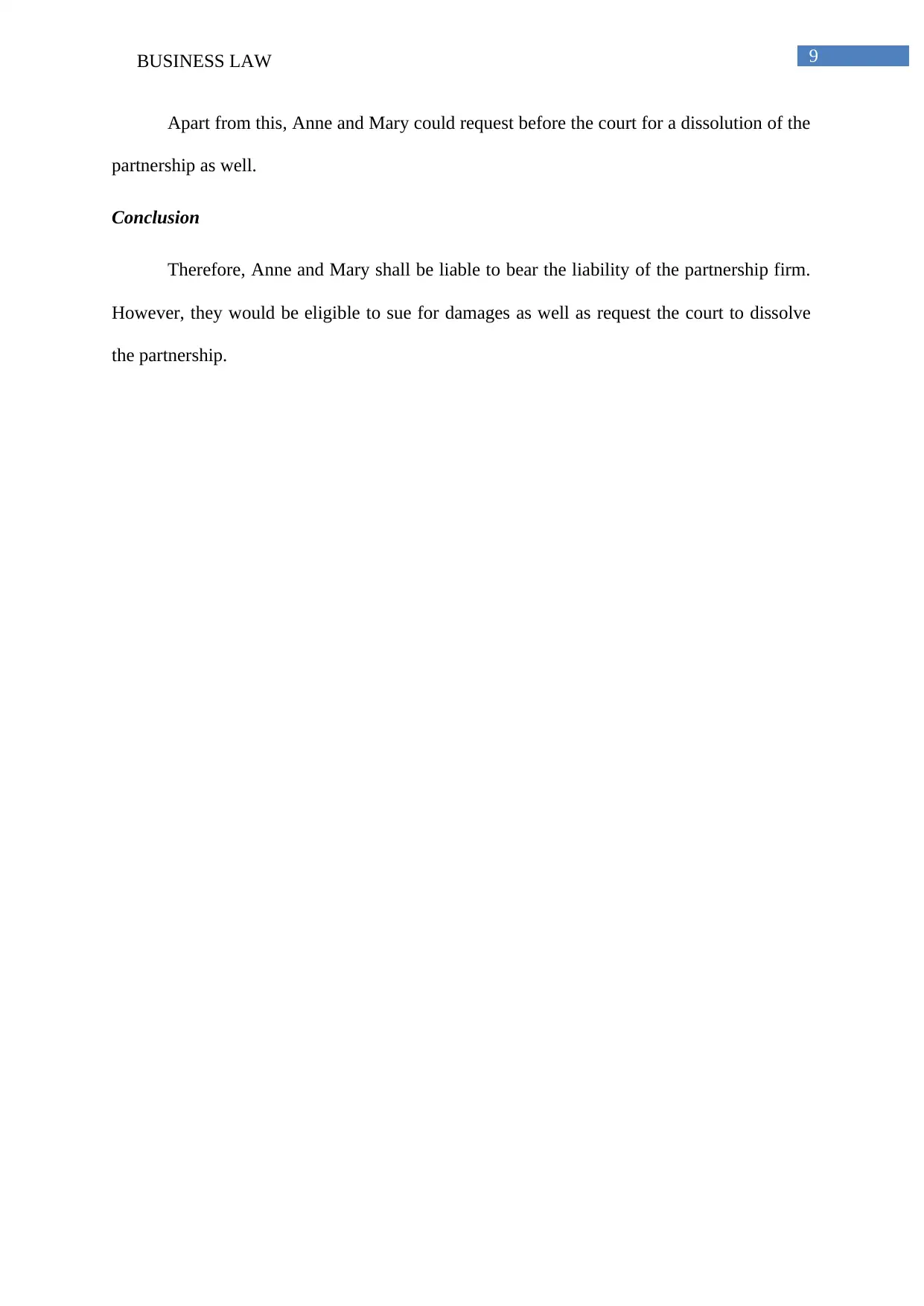
9BUSINESS LAW
Apart from this, Anne and Mary could request before the court for a dissolution of the
partnership as well.
Conclusion
Therefore, Anne and Mary shall be liable to bear the liability of the partnership firm.
However, they would be eligible to sue for damages as well as request the court to dissolve
the partnership.
Apart from this, Anne and Mary could request before the court for a dissolution of the
partnership as well.
Conclusion
Therefore, Anne and Mary shall be liable to bear the liability of the partnership firm.
However, they would be eligible to sue for damages as well as request the court to dissolve
the partnership.
Paraphrase This Document
Need a fresh take? Get an instant paraphrase of this document with our AI Paraphraser
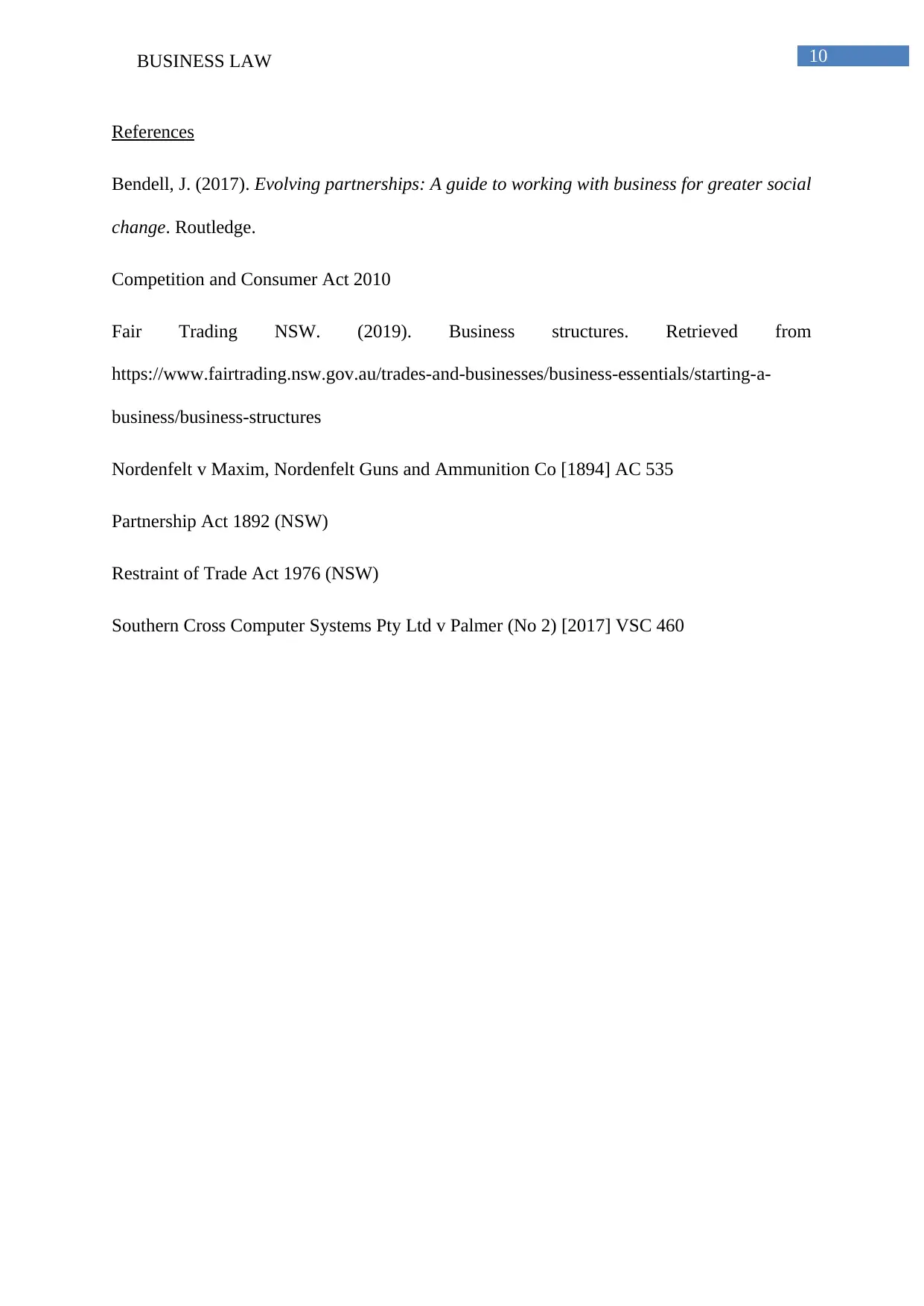
10BUSINESS LAW
References
Bendell, J. (2017). Evolving partnerships: A guide to working with business for greater social
change. Routledge.
Competition and Consumer Act 2010
Fair Trading NSW. (2019). Business structures. Retrieved from
https://www.fairtrading.nsw.gov.au/trades-and-businesses/business-essentials/starting-a-
business/business-structures
Nordenfelt v Maxim, Nordenfelt Guns and Ammunition Co [1894] AC 535
Partnership Act 1892 (NSW)
Restraint of Trade Act 1976 (NSW)
Southern Cross Computer Systems Pty Ltd v Palmer (No 2) [2017] VSC 460
References
Bendell, J. (2017). Evolving partnerships: A guide to working with business for greater social
change. Routledge.
Competition and Consumer Act 2010
Fair Trading NSW. (2019). Business structures. Retrieved from
https://www.fairtrading.nsw.gov.au/trades-and-businesses/business-essentials/starting-a-
business/business-structures
Nordenfelt v Maxim, Nordenfelt Guns and Ammunition Co [1894] AC 535
Partnership Act 1892 (NSW)
Restraint of Trade Act 1976 (NSW)
Southern Cross Computer Systems Pty Ltd v Palmer (No 2) [2017] VSC 460
1 out of 11
Related Documents
Your All-in-One AI-Powered Toolkit for Academic Success.
+13062052269
info@desklib.com
Available 24*7 on WhatsApp / Email
![[object Object]](/_next/static/media/star-bottom.7253800d.svg)
Unlock your academic potential
Copyright © 2020–2025 A2Z Services. All Rights Reserved. Developed and managed by ZUCOL.





